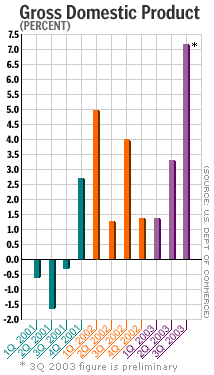NEW YORK (CNN/Money) - U.S. economic growth surged in the third quarter at the fastest pace in nearly two decades, the government said Thursday, but even President Bush admitted that was unlikely to be sustained.
Gross domestic product (GDP), the broadest measure of economic activity, grew at a 7.2 percent annual rate in the quarter after growing at a 3.3 percent pace in the second quarter, the Commerce Department reported. Economists, on average, expected GDP growth of 6 percent, according to Briefing.com.

"This is obviously an extraordinarily strong report, led by the consumer, but also with good signs about the state of the business sector and business confidence," said Lehman Brothers economist Drew Matus.
The burst of GDP growth was led by a 6.6 percent jump in consumer spending, the fastest pace since the third quarter of 1997. Consumer spending grew at a 3.8 percent pace in the second quarter.
Child tax credit checks and lower rates of income tax withholding helped fuel the third-quarter spending surge, enabling the Bush administration -- which pushed for tax cuts earlier this year -- to take a victory lap Thursday morning.
"The tax relief we passed is working. We left more money in the hands of the American people and the American people are moving this economy forward," Bush said at a speech in Columbus, Ohio. He cautioned: "We cannot expect economic growth numbers like this every quarter."
The new numbers could provide a big political boost for Bush as he heads into an election year, but Democrats said the president had little to do with the growth and blamed him for job losses during his presidency.
"We've lost more than 3 million jobs," Sen. Joseph Lieberman of Connecticut, a Democratic presidential candidate, said, according to Reuters. "This president still has no real plan to sustain this growth, translate it into jobs, and rebuild a strong middle class."
Still few jobs
While Treasury Secretary John Snow predicted this month the economy would soon be adding 200,000 jobs a month, other White House officials Thursday were quick to note the recent burst of growth has yet to create many jobs.
"We need to continue to act to build upon the steps we have taken to get our economy growing so we can continue to translate growth into job creation," said White House spokesman Scott McClellan, according to a Reuters report.
The Labor Department, in a separate report Thursday, said new weekly claims for unemployment benefits were still relatively high in the week ending Oct. 25.
In fact, during a quarter with the strongest growth rate since 1984, total employment fell by 165,000 jobs, according to Labor Department statistics, in part because of strong productivity growth, which enables companies to get more work out of fewer workers.
But most economists hope that continued strong demand will eventually catch up with the recent gains in productivity and lead to sustained job growth.
"The good news for workers is that productivity growth cannot continue at this pace. Demand will translate into jobs very soon, and in fact I think it's happening right now," said Bill Cheney, chief economist at John Hancock Financial Services in Boston.
"But that's still largely a hope, not a certainty," Cheney added.
The impact of inventories
Many economists expect the impact of the tax cuts to fade in the fourth quarter, and the cash flow from mortgage refinancings, another boon to third-quarter growth, is expected to diminish as well. As a result, most analysts expect GDP growth of about 4 percent in the fourth quarter.
| Related stories
|

|
|
|
|
A decline in business inventories in the third quarter, however, could mean GDP will get a boost in the fourth quarter, if and when businesses restock their shelves.
"The plunge in inventory accumulation does suggest that firms are not confident enough to add merchandise to their shelves," said Anthony Chan, chief economist at Banc One Investment Advisors. "But they will not be able to do this indefinitely because everyone knows that sporting empty shelves in a rising growth environment is not prudent."
Without the decline in inventories, final sales rose at a 7.8 percent pace in the third quarter, the strongest rate since the second quarter of 1978, when final sales were rose at a 16.7 percent rate.
Cars, homes lead the charge
Much of the strength in consumer spending in the third quarter was in durable goods, items meant to last three years or more, and much of that came in sales of motor vehicles and parts. Home sales also soared, with residential investment up at a 20.4 percent annual pace, compared with 6.6 percent in the second quarter.
Nonresidential fixed investment rose at an 11.1 percent rate, following the second quarter's 7.3 percent pace, a sign of further strength in business spending. Investment in equipment and software rose 15.4 percent, the strongest rate since the first quarter of 2000 and nearly double the prior quarter's pace.
Weakness in imports -- which subtract from GDP, since they represent goods and services bought from other nations -- also helped GDP growth. Imports grew at just a 0.1 percent pace while exports surged 9.3 percent.
Government spending, which contributed mightily to second quarter growth, slowed down as defense spending, which surged 45.8 percent in the second quarter, driven by spending on the war in Iraq, was flat.
An inflation measure closely watched by the Federal Reserve rose to 1.7 percent from 1 percent the prior quarter.
The Fed recently left interest rates unchanged at levels not seen consistently since 1958, saying the recent surge in economic growth had not changed its outlook for inflation. The Fed has maintained for several months that it is worried about inflation getting too low, which could hurt corporate profits and economic growth.
"We believe that the Fed will require both consistent solid hiring and a rise in inflation before it begins to lift rates," said UBS Warburg chief economist Maury Harris.

|

